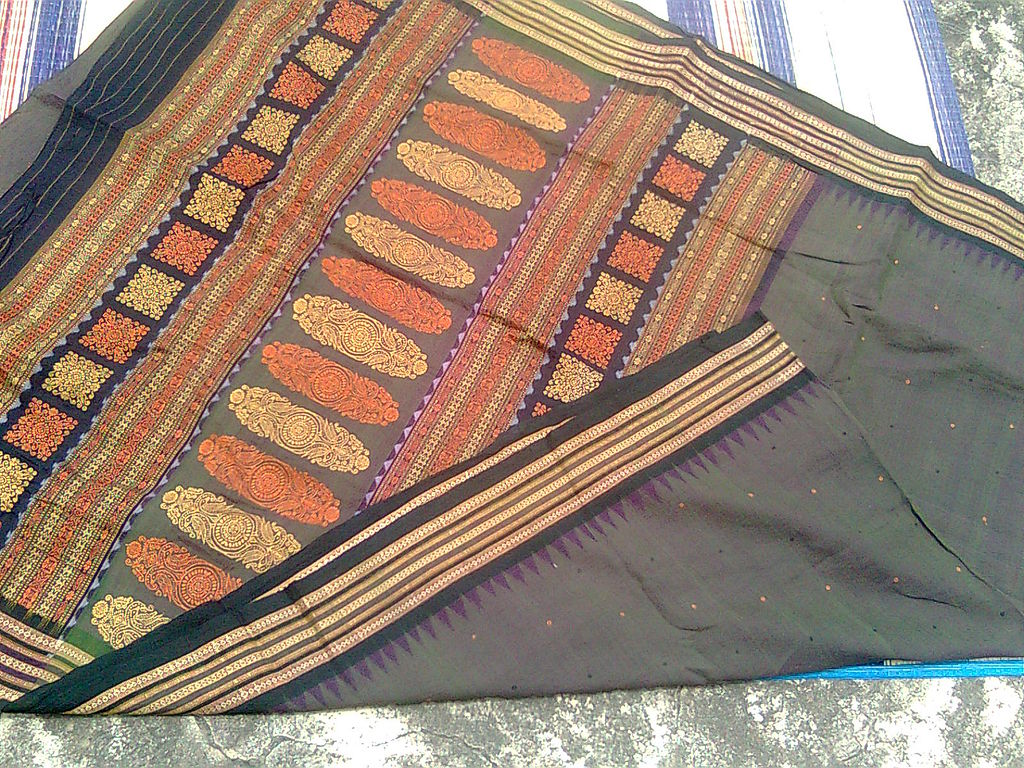Bomkai Saree derives its name and origin from a small village of Odisha called Bomkai. The speciality of the Bomkai saree is its woven fabric and artwork. Bomkai saree is also known as Sonepuri saree. It uses the dying technique of ‘Ikat’. The term ‘Ikat’ is believed to be derived from the Indonesian term ‘Mangikat’ which means knotting threads for the dying process before the weaving.

Bomkai sarees are produced mainly by the Bhulia community of Subarnapur. Bomkai saree’s and work’s popularity can be seen at various fashion shows.
About Bomkai Sarees
Bomkai sarees are a blend of traditional and contemporary designs. You will mostly see a fish design in the bomkai saree because they are a sign of success and prosperity. The main element of bomkai saree is its pallu and border which is woven with colourful threads. Bomkai sarees have a hint of tribal design in them. The designs are simple yet charming. The main colours of the bomkai saree are black, white, and red. Sarees are dyed several times before they achieve the desired results. Contemporary sarees do not restrict themselves to these three colour background, you will see various coloured bomkai sarees in the market.
Designs of Bomkai Saree
What marks the difference between bomkai saree and any other saree is the stories told on these by artisans. You will find mythological scenes and stories of the past woven on bomkai sarees. Some will have mythologies known worldwide and some will have stories of Orissa culture only. Motifs of Bomkai are inspired by nature. Some main motifs are lotus, peacock, carp-fish, and fly.
The colours of bomkai sarees contrast with each other. You will see a yellow coloured saree with a green colour design on it or vice versa or you will see an orange colour saree with a black border. More colours are used in a contrasting manner.
Making of Bomkai Saree
Initially, bomkai sarees were made using the Jaala technique in which cotton count is low. Weft and warp both techniques are used by artisans to make bomkai sarees. To keep up with the modernization and fulfil the market design artisans had to bring some changes in the design but it has not changed the fact that people love Bomkai sarees. The most recent development Bomkai made was to introduce Zari work into its weaving. Aishwarya Rai wore ‘Radhakunja’ a type of bomkai saree in her wedding.
History of Bomkai Saree
Locally bomkai is known as ‘Bandha’. It has been a part of Orissa’s culture since 600 B.C. It is believed that the first bomkai evidence was found from the Egyptian ruler’s tombs. Initially, bomkai art clothes were produced only for novelty or upper caste brahmins of Odisha. Even in modern days, Bomkai is worn by Brahmins during rituals.
During the rule of Ramai Dev bomkai art was introduced in ‘Sonepur’. The complex weaving pattern of Bomkai design can be found in the khandagiri caves of Odisha.
Cotton bomkai sarees are worn casually and sometimes in festivals whereas bomkai silk sarees are saved for greater occasions. The process of Bomkai saree is lengthy, it could take up to seven months to complete one saree.
